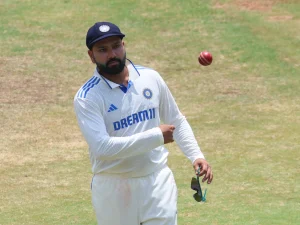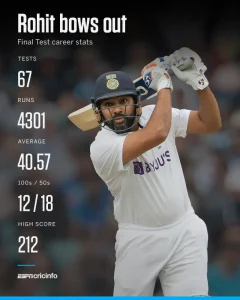New Delhi – In a shocking development that has sent ripples through the cricketing world, Rohit Sharma’s Test retirement was announced by the veteran cricketer himself on Wednesday. The 38-year-old Indian captain took to social media to declare his immediate departure from the longest format of the game, shortly after reports surfaced that he was set to be removed from Test captaincy ahead of the upcoming England tour.
Rohit Sharma Test Retirement Comes After Captaincy Removal Reports
Rohit Sharma’s Test retirement announcement came through a brief but emotional Instagram story where the opener expressed gratitude for his Test journey. The timing of the announcement is particularly significant as it followed closely on the heels of media reports suggesting that the Ajit Agarkar-led selection committee had already decided to strip him of Test captaincy due to recent poor performances and results.

According to credible sources, the selectors had informed the BCCI about their decision to look beyond Rohit for Test leadership, with the board reportedly backing this call. Rohit Sharma’s Test retirement thus appears to be a response to these behind-the-scenes developments, choosing to bow out on his own terms rather than continue as a player without the captain’s armband.
Also Read: 25 Airports Closed Across India: Operation Sindoor’s Bold Impact
A Distinguished Test Career Cut Short


Rohit Sharma’s Test retirement brings down the curtain on a remarkable red-ball journey that truly blossomed in the second half of his career. With 4301 runs in 67 Tests at an average of 40.57, including 12 centuries and 18 half-centuries, his numbers reflect a player who overcame early struggles to establish himself as a formidable Test opener.
What makes Rohit Sharma’s Test retirement particularly poignant is his transformation from a limited-overs specialist to a reliable Test batter. After years of being typecast as a white-ball wonder, his reinvention as a Test opener in 2019 breathed new life into his long-format career, resulting in some of his finest performances in the traditional format of the game.
Recent Form Struggles Precede Rohit Sharma Test Retirement
The months leading up to Rohit Sharma’s Test retirement were marked by a significant dip in his batting form. His performance in the recent Border-Gavaskar Trophy in Australia was particularly concerning, with the captain averaging just 6.20 across five innings. This followed another disappointing home series against New Zealand where he managed only 15.16 runs per innings across three Tests.
These batting struggles coincided with India’s recent Test setbacks – a surprising 0-3 home series defeat to New Zealand and a 2-3 loss in Australia that saw India relinquish the Border-Gavaskar Trophy. With Rohit Sharma’s Test retirement now official, these series will unfortunately stand as the final chapters of his Test career.
The Captain’s Dilemma That Led to Rohit Sharma Test Retirement
A deeper analysis of the events leading to Rohit Sharma’s Test retirement reveals the complex dynamics of being a captain under pressure. Sources close to the team suggest that Rohit’s dual role as captain and struggling batter created uncomfortable situations, particularly during the Australia tour.
After missing the Perth Test due to the birth of his child, Rohit’s return saw him experimenting with his batting position before finally dropping himself from the playing XI for the Sydney Test – an unprecedented move for an Indian captain. This decision, while commendable from a team-first perspective, highlighted the difficult position he found himself in and may have contributed to the selectors’ reported decision to look for new leadership.
The announcement of Rohit Sharma’s Test retirement effectively resolves this dilemma, allowing the team to transition to new leadership without the awkwardness of demoting a sitting captain.
Selectors’ Vision for Post-Rohit Sharma Test Retirement Era
Even before Rohit Sharma’s Test retirement announcement, the selection committee had reportedly been considering options for new Test leadership. According to sources quoted in The Indian Express, “The selectors’ thought process is clear. They want a new leader for the England tour and Rohit doesn’t fit in as a captain, especially considering his red-ball form. They want to groom a young leader for the next Test cycle.”
With Rohit Sharma’s Test retirement now official, this transition will accelerate. Vice-captain Jasprit Bumrah appears to be the frontrunner for the role, having already led India admirably in Rohit’s absence. However, concerns about Bumrah’s workload management and availability for all matches could complicate his candidacy as a full-time captain.
Other potential options to lead India post-Rohit Sharma’s Test retirement include Shubman Gill, KL Rahul, and Rishabh Pant – all considered permanent fixtures in India’s Test playing XI. Among these candidates, only Rahul has previous experience of leading India in a Test match, albeit on a stand-in basis.
Impact of Rohit Sharma Test Retirement on India’s Test Future
Rohit Sharma’s Test retirement marks the beginning of a significant transition period for Indian cricket. Beyond just appointing a new captain, the team will need to identify a suitable opening partner for the in-form Yashasvi Jaiswal. While KL Rahul has experience in this role, he has recently been batting in the middle order with considerable success.
The timing of Rohit Sharma’s Test retirement also comes at a crucial juncture in India’s World Test Championship campaign. With important series against England and Australia on the horizon, the team will need to quickly regroup under new leadership to maintain their push for a spot in the WTC final.
Legacy Beyond Numbers: Assessing Rohit Sharma’s Test Retirement Impact


As the cricketing world processes Rohit Sharma’s Test retirement, it’s worth reflecting on his legacy in the longest format. While his statistics are impressive, particularly as an opener, his impact transcends raw numbers. As captain, he led India to the World Test Championship final against Australia, continuing India’s remarkable consistency in the WTC era.
Critics might point to the recent series losses to New Zealand and Australia as blemishes on his captaincy record, but context matters when evaluating these results. The New Zealand series coincided with a general team-wide slump, while the Australia tour saw India competing valiantly despite numerous challenges including injuries and unavailability of key players.
With Rohit Sharma’s Test retirement now official, he will likely focus his energies on limited-overs cricket, where he continues to excel as captain and batter. Having led India to the ODI World Cup final in 2023, he might target the Champions Trophy as his next major goal in international cricket.
Final Word: A New Chapter After Rohit Sharma Test Retirement
Rohit Sharma’s Test retirement marks the end of a significant chapter in Indian cricket history. From his reinvention as a Test opener to his leadership during challenging transitional periods, his contributions to India’s red-ball cricket extend beyond mere statistics.
As Indian cricket prepares for the post-Rohit Sharma’s Test retirement era, the foundations he has helped build – including the emergence of exciting young talent and a never-say-die team ethos – will continue to benefit the team. While fans will miss his elegant stroke-play and tactical acumen in the longest format, his legacy as a player who successfully reinvented himself multiple times will remain an inspiration for cricketers worldwide.
With Rohit Sharma’s Test retirement now official, the attention turns to who will take up the mantle of Test leadership and how India will navigate the challenges that lie ahead in the World Test Championship and beyond.

